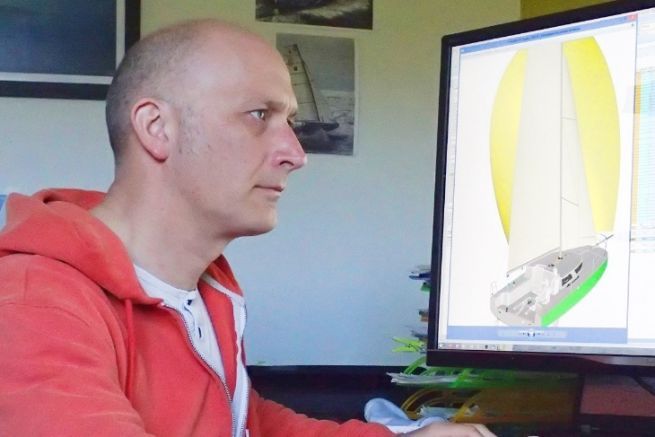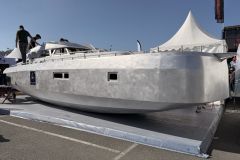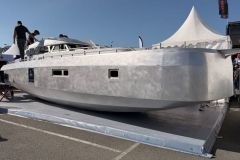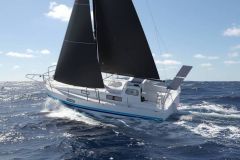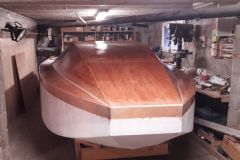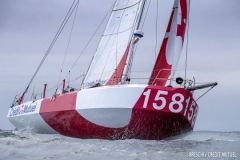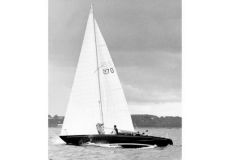A vocation
Having grown up on a cruise ship, naval architecture has always been a vocation for David Raison. As a child, he made models of boats to understand how they worked. Throughout his youth, he followed "nautical" developments, attending the starts and finishes of ocean races, including the first Mini Transat.
"My youth was steeped in these issues."
After an engineering school in hydrodynamics and shipbuilding at the Ecole Centrale de Nantes - he is also racing - he is looking for a job.
"It wasn't immediately obvious. The firms were not hiring. It was a crisis. It was hard to find work."
Mixing ocean racing and naval architecture
David Raison joins a classification company, in charge of checking ships and offshore platforms. After 3 years of collaboration, the architect embarked on his first Mini Transat in 1999 on a prototype he designed himself. He repeated the experience two years later.
In 2002, he opened his own naval architecture firm, working mainly as a subcontractor for both shipyards and his former classification company. It is only in 2015 that he will make it his main activity.
He returned to the Mini Transat in 2003 before entering the Figaro circuit in 2005.
In 2011, he won the Mini Transat on his prototype, the Magnum, a mini with a round nose, inspired by scows.

"The boat made a big splash with its rounded bow and my race win. It shifted my focus from naval engineering to naval architecture. Magnum came out in 2010, but was designed between 2006 and 2008. I did some pretty extensive studies for a Mini, including numerical simulations, to be sure of the viability of the project. As an engineer specializing in fluid mechanics, I have always done extensive studies, numerical simulations of the hull, at the level of the appendages... These are parameters that were taken into account on the very first plans that I released."
Developing hydrofoil powerboats
Between 2016 and 2018, David Raison stopped sailing competitively to join the Lorient-based company SEAir.
"We designed RIBs with foils, and I equipped my old proto with foils for this project. It was a first technical success for SEAir. We also set up a project for a foiling motor boat for the Bénéteau group. It allowed us to work in a group, unlike my activity which I do alone. It was fun."
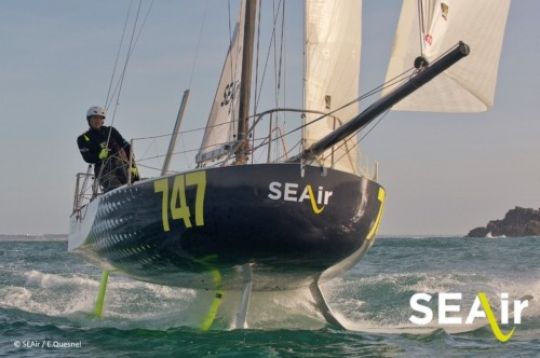
A first Class40 with great success
As a result, Ian Lipinski, who has just joined the Class40 circuit, is looking for an architect to design his boat.
"I went back to being a freelancer. I went back to competitive sailing, my first love."
To support him in his daily work, David Raison calls on a network of partners for digital engineering, structural calculations..
"Depending on the size of the projects, I either get support or work with more or less developed design firms."

To create cruising boats, to make evolve old models
But offshore racing is not the only activity of the architect since he also designed several cruising boats: Rêvolution 22/24 and 29 of the Afep Marine shipyard, or Icemint 40 of the Spanish shipyard Mint Yachts, in collaboration with François Lucas, an aluminum sailboat with lifting keel.
In addition to the creation of new units, one of the activities of the naval architect is the evolution of existing models.
"I've had requests to "recycle" Davy Beaudart's 2014 Flexirub proto. Each time, the manufacturers and customers change. I do some redesigns. In Class40 for example, the following boats evolve or are optimized. There is a lot of work to do!
I also have a great project underway with Felix de Navacelle, a 12.50m offshore cruising scow designed for a private individual. We're trying to find a shipyard and other shipowners."
With the construction of 3 Class40 Raison plans and orders for Maxi 6.50, David Raison hopes to take advantage of the opportunity to develop his practice.
"It's a good opportunity to bring out new units, take orders and grow the practice. The big challenge in our business is going from one to two people, so that's why you have to double the business."
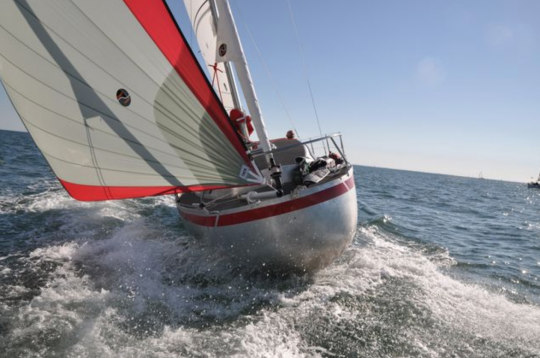
The father of scows
David Raison is known for his scow bows - the round noses - which he has made his trademark and which is now being used in naval architecture.
"I was the first to do this. Today, we're still a long way ahead of the competition on these hulls. We are on our third generation of scow with Ian Lipinski's boat. The 4th generation is under study, while our competitors are at the first generation. They are going through difficulties that we also went through, but they are brilliant people and in 4 or 5 years, we will all be equal on the scow design. We have an experience and a design method different from the others and adapted to this kind of boats.
In Class40, the Lombard firm with the Lift 40 has taken a step forward. Sam Manuard has also advanced the design in this direction with the IMOCA L'Occitane en Provence. He introduced a scow hull and managed to convince people. He has done some very good thinking about the design of the boat and the design of the foils. He brought a novelty with his buffalo horn foils. It's a different approach to flying when the other concepts are quite similar, whether they are L-shaped, C-shaped or circular.
It's going to be interesting to see how the new generation boats will evolve.
In Class40, I am looking forward to the new generation to see the innovations and concepts of my colleagues. What works or not. To know if we are still in the game with this design from 2018. There are 4 scows optimized for the 2020 rules: Etienne Bertrand's Class40 built in Cape Town, the Lombard designs built in Normandy, the VPLP designs at Multiplast and the Pogo 40 S4. It's going to be interesting to see the architects' interpretation of how the boats work and the construction issues.
A boat is always a compromise between a specification and a yard. Behind each line, there is a trade-off between advantages and disadvantages.
What makes a good boat is the elegance, the way it walks well on the water. It has to be a seaworthy and reliable boat. Then it's how well it fits the response to the customer."

 /
/ 


